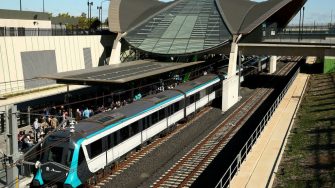In researching his book, News Media Influence on Rail Infrastructure Policy: Tracing Mediatization Through Actor–Network Theory, Dr Nicholas Richardson, a lecturer in Media in the School of Arts & Media, analysed news media spanning more than a decade, coupled with interviews with experts involved in the project, along with members of the public. The resulting book highlights the ways in which media commentary around rail infrastructure narrows the conversation to budgets, opportunity costs and political expedience. “This is a shame,” says Dr Richardson. “Decades of planning expertise has been sidelined, priorities have been set by people with little knowledge or experience and today Sydney is struggling to understand how best to grow and develop as a result.”
Dr Richardson’s research focuses on two key rail projects in Sydney, the failed Sydney City Metro (SCM) and the North West Rail Line (NWR) that succeeded it. The original SCM was meant to be the foundation for a northwest metro. The corridor was planned through Gladesville to Epping and beyond. The land was set aside. However, the part that was announced by the then Labor government went only a few kilometres from the city to Rozelle. “With a price tag in the billions, the media could not see the logic in the project and tore it apart,’ says Dr Richardson. “Then, when it was inevitably cancelled, the same media criticized the government for failing to deliver anything significant for the transport network in Sydney.
“My review of news reports of the time indicated an overwhelming sense of pressure to deliver mounting on government. A disproportionately large number of Sydney Morning Herald and Daily Telegraph articles on the SCM were negatively inclined towards the project generally or towards aspects of it. The media output was overwhelmingly and consistently negative.”
Barry O'Farrell as the leader of the opposition Liberal party recognised an opportunity and campaigned in the 2011 State election on a promise to finally deliver transport to the northwest through the NWR–an extension to the existing commuter rail line from Epping to Rouse Hill.
“A train doesn’t simply connect a growing city. It shapes that growth for future generations. That is the story that needs to be told in more meaningful ways by media and governments alike.”
Although the rail line was opened in 2019 and the election promise seemingly delivered at last, the reality is more complicated. “The delivered project is very different to the one announced,” explains Dr Richardson. “It went from being a heavy commuter rail to driverless metro rapid rail and then it was extended to Chatswood.
“It also created as many problems as it solved,” Dr Richardson argues. “The existing commuter rail line over the bridge and into the city was already at capacity. There was nowhere to accommodate the extra passengers.”
In order to accommodate an increased number of commuters, the line is now in the process of being extended into the city and beyond.
Is the new metro the right transport for Sydney?
Richardson argues that because the metro is being built around an election promise, Sydney is building the system back to front.
“You could say. ‘What does it matter, northwest metro has finally been delivered.’ However, the problems with today’s route, are being acutely felt with Sydney’s housing crisis. Every metro line on the cityside of Epping either replaces or mirrors existing rail lines. That means the parts of Sydney the new lines run through have largely been developed into higher density areas already. If the Northwest metro had followed the original plan, then it would have run through Drummoyne, Gladesville and out to the Northwest hills opening new opportunities to accommodate much needed higher density precincts closer to the city.”
“Premier Minns has been reported to be looking to add stations to the proposed western metro line in response to pressure to deliver additional housing stock for Sydney,” says Dr Richardson, who worries this is another example of government and politicians planning on the run, in response to media pressure. ‘The media are incredibly focussed on housing shortages at the moment,’ says Dr Richardson. ‘The cost of housing is constantly in the news. Premier Minns is looking to respond. Are the reported changes to the western metro plan informed by well-considered planning or are they the type of planning by press release that so frustrates the experts I interviewed?’
Rapid rail infrastructure development is an arena defined by contradictory interests spread over considerable geographical distances, as well as across multiple governmental jurisdictions. Dr Richardson argues this makes it a difficult subject for the media to meaningfully report about planning debates. “The general pressure on journalists to produce, and on government to respond to news content within a 24/7 news media cycle is immense,” says Dr Richardson. “A communications expert I interviewed referred to it as the media beast because it is voracious in appetite and antagonistic in nature. We have to ask ourselves, is thoughtlessly feeding this beast the right thing to do? We need to rile against the pressure to deliver media content when it is at the expense of proper planning. There is too much at stake.”
Part of Dr Richardson’s research was on the Montreal Métro, which recently turned fifty. After visiting Canada to see the railway, Dr Richardson returned to Sydney adamant that there are deeper, richer and more compelling ways of thinking about what rapid rail can deliver for a city. “A train doesn’t simply connect a growing city. It shapes that growth for future generations. That is the story that needs to be told in more meaningful ways by media and governments alike.”
News Media Influence on Rail Infrastructure Policy: Tracing Mediatization Through Actor–Network Theory was released on November 16.

